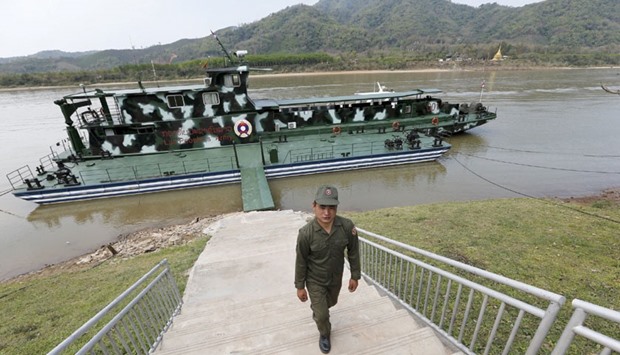
A Laotian soldier walks up a stairway in front of an army patrol boat on the Mekong river port of Mouang Mom on the Laos side of the Golden Triangle, the border between Laos, Myanmar and Thailand.
The Lao People’s Army patrol boat was custom-made in China with night-vision capability and two of the most powerful engines on this remote stretch of the Mekong River.
Today, like most days, it sits idle for lack of gasoline, guarded by a single Laotian soldier in flip-flops.
Even occasional patrols by boats like these, supplied by China to the Laotian army and Myanmar police, have successfully subdued the pirates who once robbed the Mekong’s cargo ships with impunity since Chinese-led joint patrols began in 2011.
But there has been little progress on another objective - stemming the flood of illicit drugs - exposing the limits of China’s hard power in mainland Southeast Asia even as Beijing accelerates its militarisation of disputed islands in the South China Sea.
While attacks on Mekong shipping have tailed off, drug production and trafficking in the untamed region, known as the Golden Triangle, is booming — despite the presence of Chinese gunboats and units of Chinese armed police along the Mekong.
The UN Office on Drugs and Crime (UNODC) estimates that Southeast Asia’s trade in heroin and methamphetamine was worth $31bn in 2013.
“That’s bigger than the economies of some Southeast Asian countries,” says Jeremy Douglas, the UNODC’s Asia-Pacific chief. “It’s like having an undeclared sovereign state in your midst with no borders and lots of money.”
Enter another Mekong boat, looking at first glance like a pleasure cruiser filled with middle-aged tourists. In fact, they are senior police and drugs experts from five countries, among them one of China’s top anti-narcotics officials, Wei Xiaojun.
Arranged by the UNODC and lent further clout by Wei’s involvement, their recent voyage down the Mekong was aimed at mustering the regional collaboration needed to tame the Golden Triangle.
Reuters was invited to join the four-day trip from the Chinese port of Jinghong through the heart of the Golden Triangle.
Wei, who is deputy secretary general of China’s National Narcotics Control Commission (NNCC), called drugs the “main threat” along the Mekong.
“All other types of organised crime are rooted in the drug business, like human trafficking, money laundering and the illegal wildlife trade,” he said.
China is a favourite destination for Myanmar’s drugs, which are flowing through Asia in unprecedented quantities.
More than 250mn methamphetamine pills, better known by their Thai name “ya ba” or “crazy medicine”, were seized in East and Southeast Asia in 2013, an eight-fold increase from 2008.
Seizures of “crystal meth” or “ice” — a potent, crystalline form of methamphetamine dubbed “the poor man’s cocaine” — doubled during the same period. In 2015, China seized a record 36.5 tonnes of methamphetamine, most of it from Myanmar, said the UNODC.
Myanmar is the world’s second largest producer of opium, the bulk of which ends up in China as heroin. A recent report from the NNCC raised concerns about the involvement of some Chinese military personnel in drug trafficking, and said the number of registered drug users in China rose to more than 2.3mn in 2015. Increasingly Myanmar too has a drug problem, with police last year making record-breaking busts of both ya ba and ice.
This could severely test the new government of Aung San Suu Kyi, whose National League for Democracy party has yet to formulate drug policies, say experts.
Many factors combine to help the Golden Triangle’s drug industry prosper. The Myanmar-Laos border, which the Mekong delineates, is mostly unguarded. The terrain is rugged and hostile, with rebel armies holding sway in some areas and drugs and money-laundering flourishing in lawless enclaves on both sides of the river.
Regional law enforcement agencies are often underfunded and ill-trained, and the intelligence they gather is not effectively shared with neighbouring countries. In October 2011, a gang led by a Mekong pirate called Naw Kham murdered 13 Chinese sailors. He was hunted down in Laos, then taken back to China to be tried and executed.
Afterwards, Chinese gunboats began patrolling further downriver, extending China’s security reach far beyond its borders.
This includes a riverside facility in Muang Mom in Laos, which Reuters visited, run and guarded by a 25-strong unit of Chinese People’s Armed Police.
China conducts monthly joint patrols with its Laotian and Myanmar counterparts, who — gasoline permitting — do additional patrols by themselves.
There have been successes. In 2013, a Chinese-Laotian patrol found 580kg of ya ba, worth more than 100mn yuan ($15mn), hidden in a cargo ship.
But more patrols were needed, said the UNODC’s Douglas, and Mekong countries also needed to co-ordinate and share intelligence to interdict more drugs.
Some areas remain intelligence black holes. Hsop Lwe, for example, is Myanmar’s busiest port on the Mekong, but its government has no control over it.
The port belongs to Special Region 4, a semi-autonomous enclave famous for gambling, prostitution and narcotics. To the north is Special Region 2, also controlled by heavily armed rebels.
The Special Regions were “off the political grid,” said Douglas, although he hoped Suu Kyi’s new government would engage with and secure better access to them.
The UNODC boat could not get permission to stop at Hsop Lwe, where a Chinese cargo ship was unloading SUVs as it passed.
Reuters reporters also spotted unofficial Mekong ports in Laos, which this year chairs the Association of Southeast Asian Nations (Asean).
Landlocked and impoverished, Laos shares a border with all the Mekong countries, which also include Vietnam and Thailand, making it an important smuggling hub for both narcotics and the chemicals that make them.
